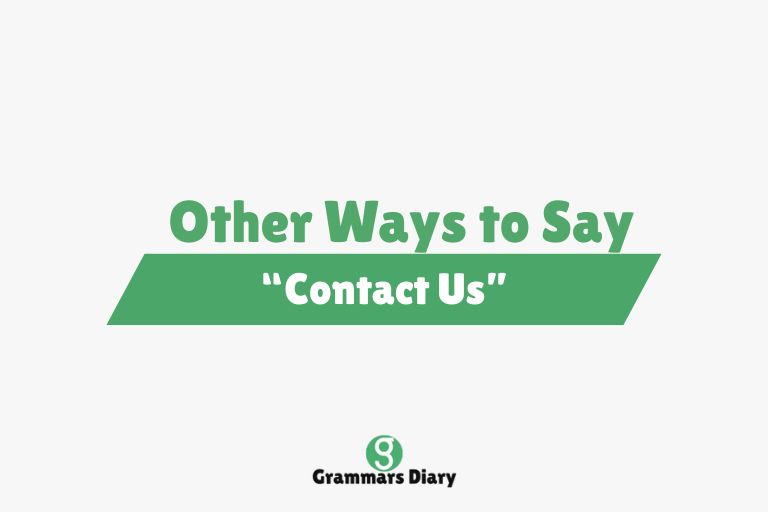The phrase “Contact Us” is one of the most widely used expressions on websites, business cards, email footers, and customer service sections, serving as an invitation for customers, clients, or visitors to initiate communication, ask questions, seek help, or engage with a company or individual. For example, when someone sees “Contact Us” on a webpage, they immediately recognize it as the go-to portal for reaching out with concerns, inquiries, or feedback.
Yet, despite its clarity and simplicity, using “Contact Us” repeatedly across platforms can begin to feel repetitive, robotic, or lacking in personal tone. Fortunately, the English language offers a wide range of compelling alternatives that not only serve the same purpose but can also better align with your brand’s voice—whether that tone is casual and friendly, professional and formal, or engaging and creative. This article aims to showcase 25 alternative ways to say “Contact Us,” each with a clear explanation and context, to help diversify your communication strategies while keeping your message accessible and inviting.
Other Ways to Say “Contact Us”
1. Get in Touch
Example: “If you have any questions, please get in touch with our team.”
Meaning: This phrase conveys a casual yet polite invitation to open communication, often used to establish approachability without sounding overly formal.
Usage: Common in websites, newsletters, and social media where a relaxed and friendly tone is desired.
2. Reach Out
Example: “Feel free to reach out if you need additional support.”
Meaning: Encourages someone to initiate contact, often implying a welcoming, empathetic, or customer-first attitude.
Usage: Perfect for customer service or support environments, especially when offering assistance.
3. Drop Us a Line
Example: “Got feedback? Drop us a line—we’d love to hear from you.”
Meaning: A more casual and slightly informal way to say “send us a message” or “contact us.”
Usage: Suitable for creative or lifestyle brands looking to sound warm and conversational.
4. Let’s Connect
Example: “Let’s connect to explore how we can work together.”
Meaning: Suggests a mutual, engaging form of communication, often used in networking or partnership contexts.
Usage: Works well on business development pages, social bios, or team intros.
5. Talk to Us
Example: “Talk to us about your experience—we’re here to listen.”
Meaning: Encourages two-way dialogue and shows openness to communication, usually in customer-centered platforms.
Usage: Effective in feedback sections, reviews, or help pages.
6. Send Us a Message
Example: “Have a quick question? Send us a message and we’ll get back to you soon.”
Meaning: A literal, clear invitation to initiate written communication, whether by form, chat, or email.
Usage: Common on contact forms or messaging interfaces.

7. We’d Love to Hear From You
Example: “We’d love to hear from you—your feedback helps us grow.”
Meaning: Personal and inclusive, this phrase invites users warmly while emphasizing their importance.
Usage: Frequently used in customer engagement areas like testimonial or support pages.
8. Drop Us a Note
Example: “Drop us a note if you’d like more details about our service.”
Meaning: Informal and friendly, it’s a lighthearted way to request communication through text or email.
Usage: Fits relaxed brands, newsletters, or promotional pages.
9. Send Us an Email
Example: “You can always send us an email at support@example.com.”
Meaning: Direct and clear, guiding users to a specific channel.
Usage: Ideal for support sections or contact details pages where email is the primary method.
10. Write to Us
Example: “Write to us with any inquiries and we’ll respond promptly.”
Meaning: Slightly more formal than “drop us a line,” this implies written contact via email or form.
Usage: Suitable for professional services, especially those dealing with client correspondence.
11. Message Us
Example: “Message us on social or through our contact form.”
Meaning: Directs users to use chat or messaging features without formal tone.
Usage: Great for brands with active social media or mobile-friendly contact options.
12. Connect With Our Team
Example: “Connect with our team to discuss how we can help your business.”
Meaning: Professional and team-oriented, it highlights collaboration and personalized attention.
Usage: Works well for B2B companies or service-based industries.
13. Give Us a Shout
Example: “Give us a shout if you need anything—day or night.”
Meaning: Informal, energetic, and cheerful—this phrase invites contact in a casual way.
Usage: Best for young or playful brands, lifestyle blogs, or creative studios.
14. Contact Our Support Team
Example: “Having trouble? Contact our support team for assistance.”
Meaning: Offers a direct and formal route to professional help, clearly assigning responsibility to a designated group.
Usage: Essential for help desks, tech companies, or service providers with a dedicated customer service structure.
15. Reach Our Office
Example: “You can reach our office between 9 AM and 5 PM, Monday to Friday.”
Meaning: Clearly communicates the possibility of getting in touch by phone or visiting physically, often including operating hours.
Usage: Ideal for businesses with physical locations or phone-based service.
16. Speak With a Representative
Example: “Speak with a representative to explore your service options.”
Meaning: Encourages direct communication with a trained person, often suggesting a more guided or personalized approach.
Usage: Common in corporate, sales, or consultation-based industries.
17. Start a Conversation
Example: “Start a conversation today and find out how we can support your goals.”
Meaning: Invites users to begin an open, exploratory dialogue, suggesting an ongoing relationship rather than a one-time contact.
Usage: Effective in relationship-building sectors like coaching, consulting, or creative services.
18. Say Hello
Example: “Say hello—we love meeting new people.”
Meaning: A cheerful, low-pressure way to invite initial contact, removing any formality or hesitation.
Usage: Works for community-driven brands, creative teams, or early-stage startups.
19. Submit an Inquiry
Example: “Submit an inquiry and we’ll respond within 24 hours.”
Meaning: A structured, formal way to gather detailed questions or requests, usually through a web form or CRM system.
Usage: Ideal for agencies, legal offices, or organizations with intake systems.
20. Send Feedback
Example: “Send feedback to help us improve our services.”
Meaning: Invites open opinion-sharing, often after a purchase or experience, with the intent of continuous improvement.
Usage: Crucial in post-sale environments, user testing, or review requests.
21. Chat With Us
Example: “Chat with us live for real-time help.”
Meaning: Suggests an interactive, instant form of communication, often through a chatbot or live rep.
Usage: Prominent in e-commerce, SaaS, and any customer-driven platforms.
22. Fill Out the Form
Example: “Fill out the form below and we’ll get in touch shortly.”
Meaning: Directs users to a contact form, often serving as the first step in a structured communication process.
Usage: Widely used on websites with lead capture or inquiry forms.
23. Reach Us Anytime
Example: “Have a question? Reach us anytime—we’re always here to help.”
Meaning: Emphasizes availability and responsiveness, appealing to users needing assistance outside traditional business hours.
Usage: Effective for businesses with 24/7 support or global clients.
24. Connect With Customer Care
Example: “Connect with customer care to resolve your issue quickly.”
Meaning: Points to a specific team focused on handling user needs and satisfaction.
Usage: Common in telecommunications, airlines, retail, or large corporations.
25. Request a Call
Example: “Request a call and we’ll be in touch at your convenience.”
Meaning: Offers the user the option to schedule a call, suggesting respect for their time and availability.
Usage: Excellent for sales inquiries, consultations, or high-value service interactions.
When to Use Different “Contact Us” Alternatives
On Business Websites
When writing copy for a business or professional website, it’s best to use terms that balance clarity with tone; expressions like “Submit an Inquiry,” “Connect With Our Team,” or “Request a Call” can elevate the perceived professionalism of your brand while still guiding users toward meaningful engagement.
In Customer Service Settings
If you’re managing support channels, help centers, or feedback portals, using phrases like “Chat With Us,” “Speak With a Representative,” or “Contact Our Support Team” can make it crystal clear that real-time help is available and that user needs are being prioritized promptly.
In Personal or Informal Contexts
On blogs, portfolios, or creative service sites, informal alternatives like “Say Hello,” “Drop Us a Line,” or “Let’s Connect” add a personal and welcoming tone that encourages friendly and open interaction, without intimidating users with overly formal language.
Conclusion
While “Contact Us” is universally understood and widely accepted, it doesn’t always offer the flexibility, personality, or tone alignment that your brand or communication strategy might need. Whether you’re aiming for casual engagement, professional precision, or creative flair, the alternatives outlined in this article provide you with a robust set of tools to diversify how you invite communication. By choosing the right expression for the right context, you can better reflect your brand’s identity and make your audience feel more connected and welcome.
FAQs
What does “Contact Us” mean?
“Contact Us” is an invitation for users or customers to initiate communication, usually with a business or service provider, through a variety of methods like email, phone, or contact forms.
Is “Contact Us” formal or informal?
“Contact Us” is neutral and can be used in both formal and informal settings, but the alternatives can be adjusted depending on your audience and purpose.
Which phrase should I use instead of “Contact Us” on a creative portfolio?
For a creative or personal brand, phrases like “Let’s Connect,” “Drop Me a Line,” or “Say Hello” feel warmer and more human.
Can I use these alternatives on my business card?
Absolutely—phrases like “Reach Out,” “Get in Touch,” or “Request a Call” work well on business cards, as long as they align with your brand’s voice.











